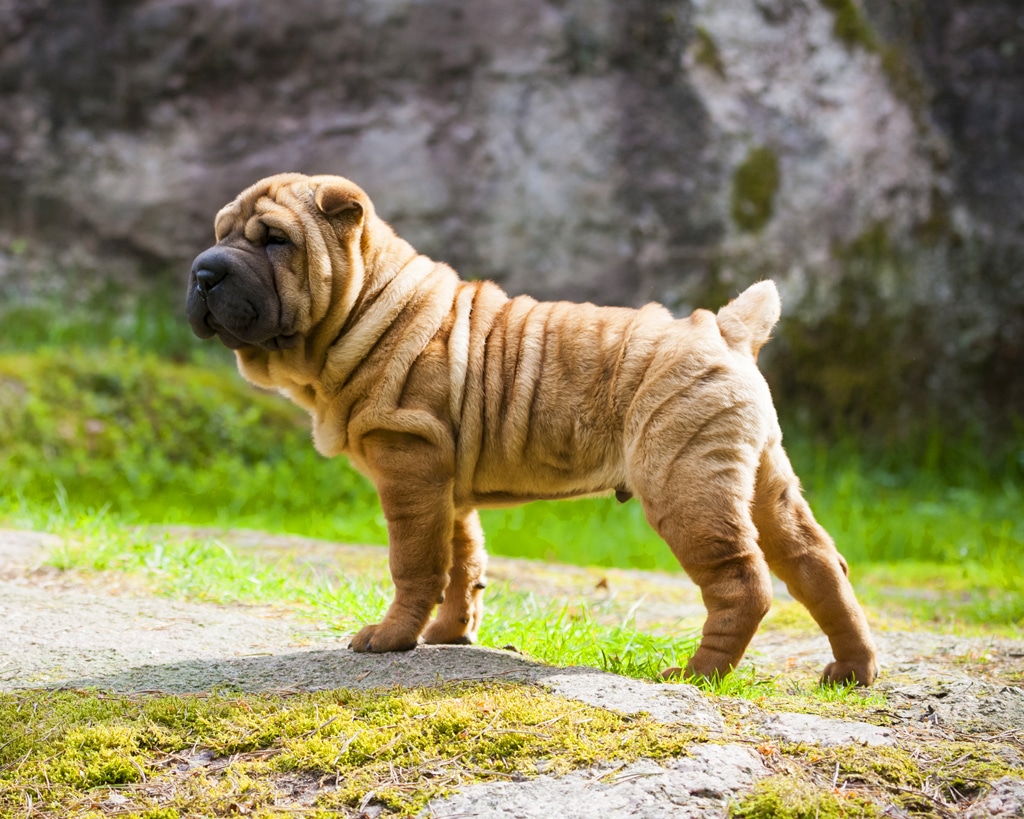

The Shar-Pei
Chinese Puzzle
An old Chinese parable tells the story of how five blindfolded people were asked to figure out what a Shar-Pei was by touch alone. The first felt the dog’s face and declared it to be a hippopotamus. The second stroked the coat from head to tail and said it was a horse. The third touched the tail and vowed she was holding a snail in her hand. The fourth pinched up a couple of rolls of wrinkled skin and asked whose baggy old sweater he had been given. The final person ran his fingers along the dog backwards from rear to front and pulled back, clutching his hand and crying “Ayee! This is a stinging nettle!”
Okay—not an old Chinese parable (I wrote it yesterday). But like the pachyderm in the original Asian fable of the six blind men and the elephant, the Shar-Pei is a creature of seemingly mismatched parts and many unusual qualities, illustrating perfectly the dictionary definition of a Chinese puzzle as “something intricate and obscure.”
Obscure as in “rare and unknown”: the Chinese Shar-Pei was once listed as the world’s rarest breed in the Guinness Book of World Records and teetered on the brink of extinction in the 1960s and 70s, mainly due to the anti-dog policy of the government in its native China during that period. A desperate effort by a Hong Kong breeder brought the wrinkled dog to the attention of the world and today the breed is ranked 68th in popularity in the United States and it is not unusual to see one at the dog park or even on TV; Peis are popular with advertisers and one was featured in the hit TV series Lost.

Lasse Ansaharju/Shutterstock
Most Popular Dogs in the US
According to the most recent AKC registration statistics (2022)
[1] French Bulldog
[2] Labrador Retriever
[3] Golden Retriever
[4] German Shepherd
[5] Poodle
[6] Bulldog
[7] Rottweiler
[8] Beagle
[9] Dachshund
[10] German Shorthaired Pointer
[68] Shar-Pei
Perhaps the Shar-Pei’s singular appearance can be linked to its unique roots: recent genetic research has shown that the Pei is one of the most ancient breeds still in existence, being the very first breed to split away from the dog’s wolf ancestors. The same genetic study reveals that the Pei’s closest relatives are the Shiba Inu, Akita, and Chow Chow. While the fluffy, sharp-nosed, prick-eared Shiba and Akita seem to bear no physical resemblance to their Chinese cousin, the Shar-Pei does share one characteristic with the Chow that no other breeds can boast: a blue or black tongue.
Undoubtedly, the first thing that one notices about the Pei is the superabundant folds of skin, particularly in the puppy, which gives the breed a highly appealing appearance that is wise, sad, and comical at the same time. Although the adult dog “grows into” its skin to some extent, many mature Peis retain heavy wrinkling, especially around the face, neck, and shoulders. Facial folds contribute to a look described in the American Kennel Club breed standard as “dignified, lordly, scowling, sober and snobbish.” The loose skin was useful to a dog that was hunting or fighting, as an attacking animal would grab a mouthful of Pei, thinking to gain a firm hold, only to find the dog literally twisting around in its skin to bring its teeth to bear on the assailant.
The texture of this baggy garment is extraordinary: the name “shar-pei” means sandy dog, a reference to the harshness of the coat. The hair is very short and prickly, sometimes drawing comparisons to a horse’s coat or a shark’s skin.
“No other canine possesses this extraordinary type of hair,” writes Ellen Weathers Debo in The Chinese Shar-Pei (T.F.H.; 1986). “The coat does have a velvety texture when one strokes the dog from head to tail, but if…stroked against the grain, it may become abrasive, producing a burning, itching sensation for some people.”
The muzzle of the Pei is, indeed, described as resembling a hippo’s mouth: large, broad, and padded, and the tail is short, thick, tapered, and carried high in a ring or curve over the back.

Eric Isselee/Shutterstock
Unfortunately, many of the characteristics that make up the distinctive look of the Shar-Pei are closely linked with health challenges. Prospective owners should be aware that the breed faces a number of issues such as chronic ear infections (due to the small size of the ear), while those adorable wrinkles can nurture a wide variety of skin problems, from mange, allergies, and bacterial infections, to abscesses. Entropion (eyelid turning inward so that the lashes scratch the eyeball) is very common and many puppies must have their eyelids “tacked” in place (sutured away from the eye) until they grow into their skins, or undergo surgery to permanently remove some of the folds around the eye. For a detailed discussion of Shar-Pei health concerns, refer to the owner guide provided online by the Chinese Shar-Pei Club of America at spca.com/PubEd/OwnerGuide.pdf.
The Pei is special—and he knows it! He is clever, but not easily swayed. He does not make friends easily but is a devoted protector of his family. A warrior lurks in the heart of every Pei.
“Shar-Pei are very intelligent, can be stubborn, and are extremely loyal to the family,” says Terry Cole of TnT Shar-Pei Rescue (tntsharpeirescue.com). “As with any dog, it is important to establish yourself and other humans in the family as leaders, and socialize, socialize, socialize!”
In The Complete Chinese Shar-Pei (Howell; 1988), Dee Gannon writes: “The Chinese Shar-Pei is not an aggressive dog. Rather, he is a thinking animal who must be allowed to assess the situation and make up his own mind as to the appropriate reaction. The job of the owner is to teach the dog good judgment.”
Like any worthwhile puzzle, the Shar-Pei is intriguing, absorbing, ever-challenging, and fun. The key to solving this puzzle is to make sure you’re not wearing any blindfolds and can see the whole animal, understanding and appreciating everything about him that makes the Pei unique.
» Read Your Breed For more breed profiles, go to moderndogmagazine.com/breeds
Join the newsletter and never miss out on dog content again!
"*" indicates required fields
By clicking the arrow, you agree to our web Terms of Use and Privacy & Cookie Policy. Easy unsubscribe links are provided in every email.






